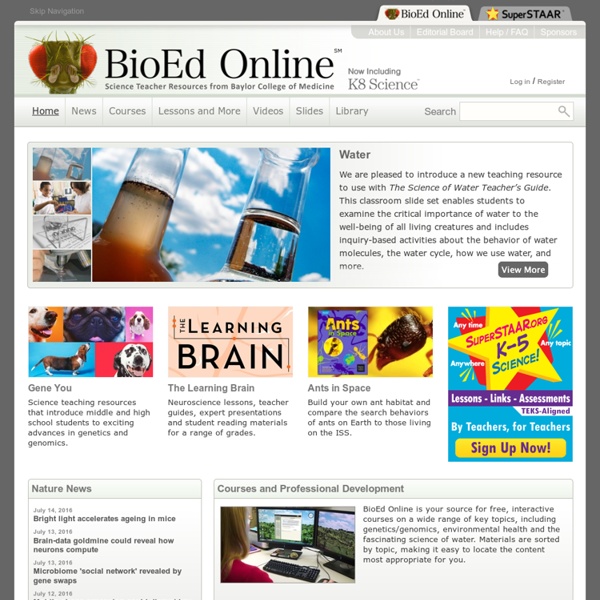



Physics To Go: Explore Physics on your own image credit: U.S. Air Force; image source; larger image Newton's 3rd Law What is the purpose of the small rotor on the back of this helicopter? In fact, it's needed because of Newton's third law--for every action force there is an equal and opposite reaction. This reaction force creates a torque that, by itself, would make the helicopter spin in the opposite direction as the rotor. (This feature was updated on September 22, 2013.) Torque Check out this PBS video to use the concept of torque to explain how one dancer can balance on top of the head of another--and on point!
ActionBioscience.org - examines bioscience issues in biodiversit Fundamental Biosciences Life sciences include disciplines of science that are concerned with the scientific study of life – including microbes, plants, and animals, including humans. Biology is an umbrella term for the natural sciences that study life, with the other life sciences serving as subfields. In our holistic approaches to health, life and wellbeing, the area of Life Sciences complements all areas of our website with a more scientific point of view to better understand the advances in bioscience and their profound implications. Also, in the area of Life sciences, we aim to promote the understanding of biodiversity of life and improve bioscience literacy to increase global ecological consciousness and promote bioscience education. We see a fundamental knowledge of bioscience as a basis to be able to improve health of humans, animals and the environment for a balanced ecosystem. Goals and Features of Bioscience on ICWB.com
ENVIRO Hands-on Activities for Teaching Biology to High School or Middle School Students by Drs. Ingrid Waldron and Jennifer Doherty, University of Pennsylvania The expression "hands-on, minds-on" summarizes the philosophy we have incorporated in these activities - namely, that students will learn best if they are actively engaged and if their activities are closely linked to understanding important biological concepts. Many of our activities are explicitly aligned with the Next Generation Science Standards, as indicated by (NGSS) in the descriptions below and the links to the right. To accommodate limited budgets, most of our activities can be carried out with minimum equipment and expense for supplies. Additional resources for teaching biology are available at More Minds on Activities for Teaching Biology. Read More Intro and Biological Molecules Is Yeast Alive? Students evaluate whether the little brown grains of yeast obtained from the grocery store are alive by testing for metabolism and growth. Enzymes Help Us Digest Food(revised, July, 2016) Who Took Jerell's iPod?
Lichtenwalner, Megan (Science) / Biology Keystone Exam Resources Starting with the class of 2017, a graduation component of any Pennsylvania public school will be passing specific Keystone exams. These exams are designed to make sure that students are meeting state standards. Starting with the 2012-2013 school year, Council Rock School District will be administering the Algebra I, Literature, and Biology Keystone exam. To help students review the topic of biology, the Science Department has broken up the content into 9 topics. A podcast (either by Khan Academy or Council Rock Staff) approximately 20 minutes in length to review the contentA viewing guide that goes along with each podcastA list of questions from the Keystone Review packet (Modified from the Science Section of the Keystone Exam information provided by the Pennsylvania Department of Education) that accompany that sectionAn electronic quiz (all quizzes found here) that students can take to assess their own knowledge
Explore Biology | Biology Teaching & Learning Resources Biotech Partners A Science Teacher Shares Tech Resources For Teachers, Parents & Students I teach Middle School Science, mainly physical, environmental, and life to 6th and 8th graders. Through grants I have acquired 14 iPads for my students to use everyday. Students are also welcome to use their own handheld devices or smartphones. Stopwatch + Calculator When we do labs, students make use of the iPad app iLab: Timer HD (not free) as a stopwatch as well as the free calculator app Pcalc Lite. A handy biology app A nice paid app for Biology is the Cell and Cell Structure app, which I was able to try out for free – my students did use it and like it. Dissection apps If your students do any animal dissection you can offer kids an alternate way to dissect virtually with Frog Dissection and Rat Dissection, both excellent apps that my students, even 6th graders who don’t do any dissecting, love to use. Office app for iPad One iPad app that we get a lot of use from is Office2 HD. Some students really enjoy creating their own animations and Doink is a great app for that.
50 Awesome Chemistry Videos For The Busy Science Teacher Though we don’t often recognize it, chemistry defines nearly every element of our everyday lives. From the reactions that fuel the sun to the biology of our bodies to the technology in our gadgets, chemistry is at the heart of everything we do and is the central science that unites biology, physics, geology, astronomy, medicine, and countless other fields. Yet chemistry doesn’t always get the credit and recognition it deserves for playing such an awesome role in, well, everything. If you’ve been slighting chemistry, there’s no better time to give the field the credit it deserves than National Chemistry Week. Founded in 1987, the week-long event has helped bring awareness to the role chemistry plays both in our lives today and in our future. Amazing Reactions and Experiments From incredible explosions to chameleon-like color changes, these experiments and demonstrations showcase some of the coolest reactions in chemistry. Lectures Courses Fun Miscellaneous
Explore Biology | Biology Teaching & Learning Resources ProjectWILD